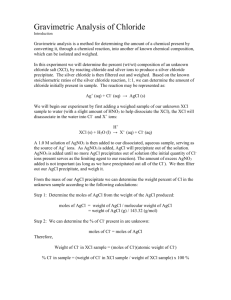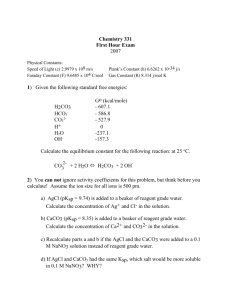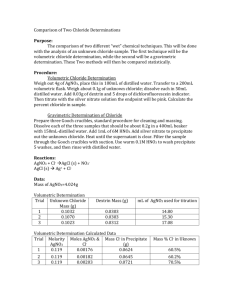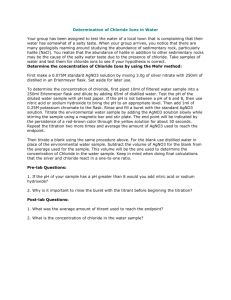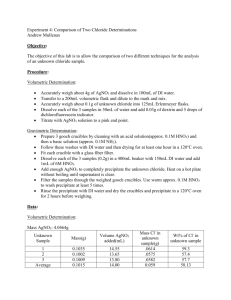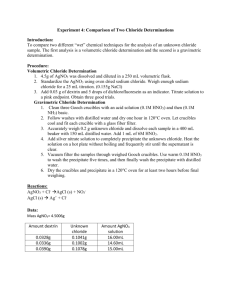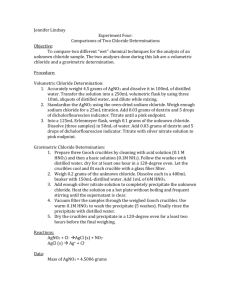Volumetric_Analysis_of_Chloride_Lab.doc
advertisement
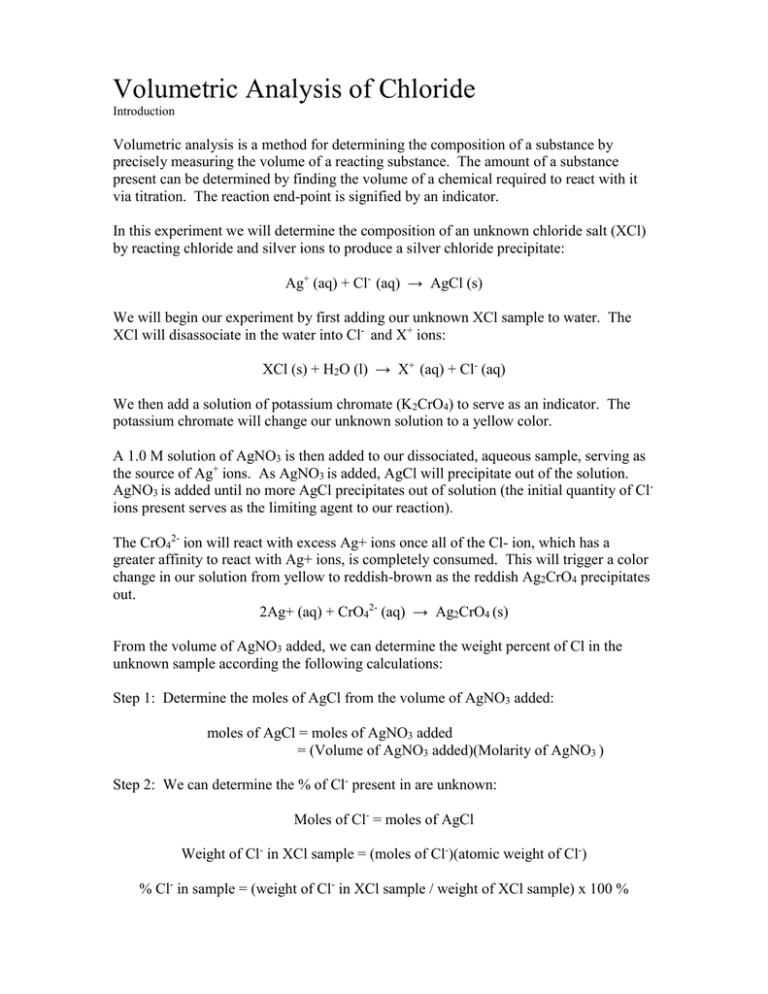
Volumetric Analysis of Chloride Introduction Volumetric analysis is a method for determining the composition of a substance by precisely measuring the volume of a reacting substance. The amount of a substance present can be determined by finding the volume of a chemical required to react with it via titration. The reaction end-point is signified by an indicator. In this experiment we will determine the composition of an unknown chloride salt (XCl) by reacting chloride and silver ions to produce a silver chloride precipitate: Ag+ (aq) + Cl- (aq) → AgCl (s) We will begin our experiment by first adding our unknown XCl sample to water. The XCl will disassociate in the water into Cl- and X+ ions: XCl (s) + H2O (l) → X+ (aq) + Cl- (aq) We then add a solution of potassium chromate (K2CrO4) to serve as an indicator. The potassium chromate will change our unknown solution to a yellow color. A 1.0 M solution of AgNO3 is then added to our dissociated, aqueous sample, serving as the source of Ag+ ions. As AgNO3 is added, AgCl will precipitate out of the solution. AgNO3 is added until no more AgCl precipitates out of solution (the initial quantity of Clions present serves as the limiting agent to our reaction). The CrO42- ion will react with excess Ag+ ions once all of the Cl- ion, which has a greater affinity to react with Ag+ ions, is completely consumed. This will trigger a color change in our solution from yellow to reddish-brown as the reddish Ag2CrO4 precipitates out. 2Ag+ (aq) + CrO42- (aq) → Ag2CrO4 (s) From the volume of AgNO3 added, we can determine the weight percent of Cl in the unknown sample according the following calculations: Step 1: Determine the moles of AgCl from the volume of AgNO3 added: moles of AgCl = moles of AgNO3 added = (Volume of AgNO3 added)(Molarity of AgNO3 ) Step 2: We can determine the % of Cl- present in are unknown: Moles of Cl- = moles of AgCl Weight of Cl- in XCl sample = (moles of Cl-)(atomic weight of Cl-) % Cl- in sample = (weight of Cl- in XCl sample / weight of XCl sample) x 100 % Volumetric Analysis of Chloride Procedure **NOTE: Use instructions provide by the instructor – DO NOT USE INSTRUCTIONS IN CHEMLAB! To remove the instructions on the screen, and free-up more working area, perform the following operation: click on the OPTIONS tab; then click on LAB ONLY. The instructions “disappear” and all of the area is now lab space.** Step 1: Obtain a 250 ml Beaker and add 2 g of unknown chloride, XCl. Step 2: Fill beaker to 100ml level by adding water, stir solution until XCl is completely dissolved. Step 3: Add 4 ml of 0.25 M potassium chromate to XCl solution (the solution will turn a yellowish color). Step 4: Obtain a 50 mL buret and fill with 1.0 M AgNO3. Slowly add AgNO3 to XCl solution (open stopcock in titration dialog box). A precipitate of AgCl will form and gradually settle. Continue to add AgNO3 until the solution turns from yellow to brownish/red - and - a reddish Ag2NO3 precipitate forms (note: the precipitate that gives the color change quickly falls to the bottom of the beaker. Thus, the brownish/red color change is brief.) At this point, record the final volume of AgNO3 from the buret. Step 5: Repeat steps 1-4, one more time and average the results. Volumetric Analysis of Chloride Name:__________ Sect:____________ Observations Data Trial #1 Initial unknown chloride sample weight (g): Initial buret volume (mL): Final buret volume (mL): Volume of AgNO3 added (mL): Trial #2 Initial unknown chloride sample weight (g): Initial buret volume (mL): Final buret volume (mL): Volume of AgNO3 added (mL): Average Volume of AgNO3 added: Average volume of AgNO3 added (mL): Calculations 1. Determine the average moles of AgCl from the average volume of AgNO3 added: 2. Determine the average weight of Cl- in XCl sample (from average moles): 3. Determine the average % Cl- in sample (from average weight of Cl-): Questions 1. How would the calculated % Cl- in sample be affected if tap water was used (containing many different anions that could possibly react with Ag+) instead of distilled water? 2. If Pb2+ had been used to precipitate the chloride, the calculation would need to be modified. How and why would you modify the calculation to account for the fact that each mole of PbCl2 contains two moles of chloride? Discussion
